Home | Pioneers | Contact Us | Copyright/Disclaimer
The Story of Michael
Power
and of
This information was supplied by Bryan Power [bryanp2-at-bigpond.com]
Foreword
Our Power families can be traced back, in Australia, to two Irish convicts transported to Sydney in the 1820s. One of those convicts was John Power who arrived in about 1822 and married Mary Donovan at Parramatta in 1837. (John and Mary Power’s story can be found on the Monaro Pioneers’ website, www.monaropioneers.com )
The other convict was Michael Power who was transported for life aboard the Lonach in 1825. Michael married Jane Crotty at Dapto in 1842.
Two of John and Mary Power’s sons married two of Michael and Jane Power’s daughters: ‘Red Johnny’ Power wed Anne Power at Eden in 1864 and James Power married Kate Power at Kiah in 1872. My line of Powers is descended from the union of James and Kate.
Dedication
This story is dedicated to the late Mrs Marion White of Brisbane, the granddaughter of Michael and Jane’s eldest son, ‘Black Johnny’ Power. From 1976 until her death, Marion maintained a correspondence with me over many years during which she gave me not only much information and many stories about the Kiah Powers but also conveyed her deep affection for her extended family over several generations.
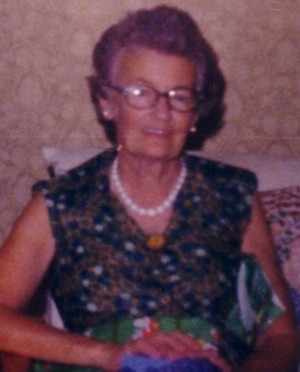
Mrs
Marion White
I also gratefully acknowledge all of the information about the family provided to me by the late Mary Ann Strangwidge (nee Power) who was a daughter of Red Johnny and Anne Power.
Jan Kersnovske and Toni Bottrell (whose husband is a descendant of the union of Michael Power and Anstatia Kiely) have also provided. much information about that line of the family. I am also very grateful to Ted Strickland of Penrith and Leonie Ivanhoe, a Stokes descendant, who did much research for me on the N.S.W. records.
Bryan Power
P.O. Box 610 Gisborne, Vic 3437
(03) 5428 2795
bryanp2@bigpond.com
22 October 1999 Revised and updated 30 January 2009
Michael Power, the convict
Michael Power was born in Ireland in 1793 in Co Waterford. As yet I have not been able to trace his parents nor any other members of his family with the single exception of his brother John who, like Michael, was transported to Australia in the early part of the nineteenth century.
In 1824 Michael was tried in Waterford on a charge of “burglariously entering and robbing the dwelling house of Mr John Duggan on the 22 June at Ballycullane” (Waterford Mirror 11 August 1824). He was found guilty by Chief Justice Bushe and sentenced to transportation for life. On 16 May 1825 he was one of 139 Irishmen aboard the “Lonach” under the command of Captain Driscoll when it sailed out of Cork Harbour on the long voyage to Sydney Cove.
According to the journal of the ship’s surgeon, Alick Osborne, the trip must have been a miserable experience for the convicts. He wrote: “We sailed ..... with strong southerly winds for eight days. Most of the convicts were country people, many of them had never seen the sea before and consequently they suffered exceedingly during that period from sea sickness.
As soon as they got over the sea sickness .... constipation and a terrific host of bowel complaints made their appearance and harrassed us the whole of the voyage.
After passing the cape late in July the weather became cold & stormy. We then issued a pair of flannel drawers to each man & a gill of wine daily, the regular allowance of lime juice & sugar of course, as usual, and giving them as much exercise in the open air as weather and circumstances would permit. About a week previous to our arrival in N.S.Wales, I discovered symptoms of scurvey in five young men of scrofulous habit & weak constitution. Livid spongy gums, pain & stiffness in the joints, slight discolouration of the skin on patches of the legs & considerable dibility (sic). I kept their bowels free, gave the nourishing diet, a glass of rum the first thing in the morning & a bottle of ale, per day, between two. This treatment appeared to produce the best effects, as the amendment was very considerable in the short space of any week; and a few days after passing they were quite well.”
The following statement was appended to the end of Osborne’s report and was written at the conclusion of the official handing over of the convicts to the colonial authorities in Sydney:
“The prisoners mustered appear in good health, declare themselves well treated and have been favourably spoken of by the Surgeon Superintendent and Commander. Muster held 6 & 7th September 1825
Singd.(sic) by
A Osborne Surgeon & Supert.
W H Driscoll Commander”
Alick Osborne made several voyages as surgeon and superintendent on convict ships and was highly regarded for the care he showed to his charges. Despite all of the sickness he had to cope with on the Lonach he managed to keep all but one of the convicts alive to disembark safely at Sydney Cove. The ship dropped anchor in Sydney on 4 September 1825 after a voyage lasting 112 days.
Osborne makes no mention by name of any convict in his report but he may have become acquainted with Michael Power as many years later (in 1844) two of Alick’s brothers signed a recommendation that Michael’s petition for a conditional pardon be granted.
Michael’s description
On the ship’s convict indent the following details are recorded concerning Michael:
Tried at Waterford on 17 August 1824 and given a life sentence. His native place was Co Waterford and his trade was ploughman. He was 32 years old, 5 feet 8 and a half inches tall with brown complexion, dark grey hair and grey eyes. His health was described as “well”.
However, the indent prepared in Ireland gives somewhat different descriptions. His age is recorded as 30, his height as 5 feet 10 inches, his hair brown and complexion swarthy. It agrees that his eyes were grey and adds that his crime was burglary & felony.
A note below Michael’s description on the former record reads: “Brother to John Power came about 13 years Ago.”
Michael’s brother, John
First of all let me make it quite clear that this John Power is not the one who married Mary Donovan.
Michael’s brother John had been sentenced in Waterford to 7 years’ transportation in August 1813. In December of that year he was taken to Dublin to board a recently built ship, the Three Bees, which was about to make its maiden voyage. The ship sailed from Dublin to Falmouth in order to pick up English felons, and with a total of 219 convicts aboard set off for Australia on 8 December. Many of the convicts came down with scurvy and nine of them died before Sydney was reached on 8 May 1814 after 149 days at sea. A further 57 men were taken to hospital on arrival; I have found no record to indicate that John was one of them.
This was to be the Three Bees only voyage. Twelve days after disembarking the convicts, the Three Bees caught fire while at anchor in Sydney Cove. The fire could not be controlled and the crew, fearing for their safety because of the 30 casks of gun powder stowed aboard, abandoned the ship and cut it adrift from its mooring. By 7.30 pm the blazing vessel had drifted to Bennelong’s Point when the magazine exploded. So ended the short life of the 459 ton convict ship.
The convict indent provides the following details for John:
Born in Co Waterford, 25 years old in 1814. (Thus John was about four years older than Michael.) John was 5 feet 9 and a quarter inches tall with “dk pale complexion, black hair and hazle (sic) eyes”. John was described as a labourer & sawyer by trade.
A little over three years later John sought the permission of Governor Macquarie to marry 16 year old Elizabeth Flaven who in 1806 had come to the colony with her parents on the Tellicherry. Elizabeth’s family were free settlers. Governor Macquarie gave his approval and Michael and Elizabeth were married at St Philip’s in Sydney on 15 September 1817 by Rev William Cowper. The witnesses, Richard Toben and Bridget Fitzgerald, marked the register with crosses as did Elizabeth. John, however, was able to sign his name. On 5 December in the following year, Elizabeth had the following petition prepared:
“To His Excellency Lachlan McQuarrie Esquire Captain General Governor and Commander in Chief in and over His Majesty’s Territory of New South Wales and its Dependencies.
The Petition of Elizabeth Flaven free girl Humbly Showeth
That Petitioner arrived in the Colony with her Parents in the Tilly Cherry in the year 1806
That Petitioner is married unto John Power at present in Government employ at Lane Cove, who has always made it his duty to behave himself in a regular becoming manner ever since his arrival in the Colony which was aboard the Three Bees in 1814 -
That Petitioner humbly begs that your Excellency will have the goodness to
grant her husband a Ticket of Leave and it shall always be Petitioner’s duty as well as that of her husband to show unto your Excellency and the world at large that your goodness has not been bestowed upon an unworthy object.
Your Excellency’s most Obedient servant
Elizabeth Flaven”
The phrase “at present in Government employ” meant that John was still serving his sentence as a convict and so would have found it very difficult to provide for a wife and family. Once he had obtained a ticket of leave he would be free to work for wages or to become self employed.
John and Elizabeth had at least seven children; the following records have been found:
NAMES BIRTH
BAPT SPONSORS
DATE DATE
1. Mary 1818
2. Catherine 23 Oct 1820 16 Sep 1826 Edward Tully & Mary Quigley
3. Elizabeth 18 Jun 1823 16 Sep 1826 Michael Fitzgerald & Ellen Conolly alias Fitzgerald
4. John 23 Jun 1826 9 Sep 1826 William Maher & Ann Ratnett Shoal Haven
5. Eleanor 1 Nov
1827 22 Dec 1827 David Norulan(?) & Ellen Fitzgerald
alias Connolly & Samuel Connolly
6. James 1830
7. Michael 1836
The baptisms were performed at St Mary’s Church, Sydney (later, St Mary’s Cathedral) by Father John Joseph Therry.
No records of Mary’s birth or baptism have been found but she appears with the family on the 1828 Census and is recorded as being two years older than Catherine.
On John’s baptismal record Fr Terry has noted “Married nine years ago in a Protestant church”, (referring, of course, to the parents not to baby John). Father Terry must have insisted that the older children be baptised too for Elizabeth and Catherine were brought to the church on the following week for the sacrament. But not Mary apparently.
Fr Therry’s writing is often difficult to read but on all of the baptismal records he has written Elizabeth senior’s maiden name quite clearly as Flanahan, not Flaven. Why, I don’t know.
At the time of the 1826 baptisms the family is recorded as living at Lane Cove. On the 1828 Census they are shown to be residing at Hunters Hill.
John petitions to have Michael assigned to him
John quickly learned of Michael’s arrival in the colony aboard the Lonach and had the following petition drafted within 24 hours to be placed before Major Goulburn, the official in charge of assigning the convicts.
“Lane Cove 5th Sept. 1825
Honored Sir,
I am a free man for many years, and reside in Lane Cove, and understand that my Brother Michael Power is on board the Lonark (sic). I have a wife and large family to maintain and my name is down in your office for several months for a Govt. Servant, I will now feel myself greatly obliged if your honor will be pleased to assign my brother to me -
I am
Honored Sir
your humble Servant
John Power”
John signed the letter but the letter itself had been written by another, a literate person who probably made his living by writing such documents for those unable to do so themselves.
John states that “I am a free man for many years” so Elizabeth’s petition on his behalf for a Ticket of Leave was apparently quite promptly successful.
He further states “I have a wife and large family to maintain”. By the standards of the time three children would not have been considered a large family so there are two possible explanations for this statement. The first one is that John and Elizabeth may have had more children than discovered in the list above. The other explanation is that John was simply exaggerating the situation in order to gain a favourable outcome for his petition.
In any case, John’s petition was successful and Michael joined his brother at Lane Cove. He was still living with John and Elizabeth at the time of the 1828 Census.
Anstatia Kiely arrives in Sydney
In the Waterford Mirror’s report of Michael’s trial in 1824, a woman by the name of Anastace Keily gave the following testimony:
“Anastace Keily swore that she heard of Mr Duggan’s house being robbed the morning after; the prisoners with others came to her father’s house, and remained drinking from six until ten o’clock; saw a pair of pistols with another man of the name of Power; witness desired Cunningham to tell the other man to put up the pistols as the Police were coming up; Cunningham said that he did not care, that they had five pistols more; another man said to the prisoner Power that he would rather have the gun in Mr Duggan’s house than all he could carry out of the house; Power was lying on a settee very tipsy when Cunningham caught hold of him and desired him to come; Power said it was time enough to go there; then, however, left the house and went down the road, not in the direction of Mr Duggan’s house which is about half a mile distant; knew Cunningham about a fortnight before; saw him going up and down the village.”
Michael Power was on trial with the man named Cunningham and the evidence of other witnesses left no doubt of their guilt. Anastace Keily’s testimony, however, was favourable to Michael on a number of points. She said that another man by the name of Power was the one with “a pair of pistols”- she said nothing about Michael being armed. She said that Michael was drunk and implied that Cunningham was attempting to force him to go with him to Duggan’s house. She added that she saw Michael going down the road but not in the direction of Mr Duggan’s house. Her evidence was, in the end, far outweighed by the testimony of the other witnesses and Michael received a life sentence. However, it is not difficult to interpret her statements as those of a friend and it was not long after her arrival in Sydney that their friendship was renewed.
Incidentally, Paul Cunningham also received a life sentence and he too was transported on the Lonach. I have found no records to indicate that he and Michael continued their association in the colony.
On 17 April 1826 in Waterford Anstatia Kiely, aged 20, was sentenced to 7 years for stealing a cloak. It was her first offence but in those days there was no hope of a second chance. Anstatia had been born in Tipperary and had never been to school before gaining employment as a house servant. For her crime she was transported to Sydney aboard the Elizabeth which was making its fourth voyage to New South Wales as a convict ship. Under the command of Walter Cock and with Joseph Hughes as Surgeon Superintendent the ship reached Sydney Cove on 12th January 1828 with 192 female Irish convicts and 16 children. Two women had died on the voyage including one who had fallen overboard and drowned. These matters were reported to the Honl. Alexander McLeay Colonial Secratary (sic) at the muster held on board the Elizabeth.
Anstatia was assigned first to Mrs Mary Jones but within a month John Power (at Michael’s urging perhaps?) had submitted this petition:
“To his Excellency General Darling Governor in chief
The humble memorial of John Power of the district of Lane Cove. Settler.
I am a married man and have 4 young children, that your humble petitioner has occasion for a female servant, and hearing that Mrs Mary Jones of Macquarie St Sydney has a servant who is not able to do her work. Your petitioner respectfully prays a transfer of the said servant to his your petitioner’s service and your petitioner will be forever thankful.”
Mrs Jones supported John’s request with the following:
“I hereby certify that with the indulgence of his Excellency I have no objection to dispense with services of Anastacia Kiely per ship Elizabeth. Cocks Master. She being unable to perform my wash as a laundress.”
A letter from the Colonial Office dated 28 February 1828 reads:
“Anastatia Kiely, ship Elizabeth to be transferred from Mrs Mary Jones who has consented to John Power of Lane Cove.”
Her service in John’s household apparently started badly for within a few days (on 3 March 1828) she was sentenced to “one month (in the) 3rd class factory and returned to her service being drunk and disorderly and absent from her service.” Perhaps she had been celebrating her reunion with Michael.
Anstatia, however, seems to have settled down after that and on 17 March 1829 she was recommended to receive a Ticket of Leave in pursuance of good conduct while in service.
Certainly the authorities would have been unaware that she was pregnant to Michael at the time; their daughter whom they named Ellen was born later that year. Their second child, Michael, was born on 8 April 1831 and her Ticket of Leave was revoked when she was discovered to be living “in an adulterous situation”.
In June of that year Michael and Anstatia applied to be married but permission was refused as it was known that Anstatia was already married - to a Martin Barry, a soldier in the 73rd Regiment stationed in Waterford. By this time Michael and Anstatia had moved away from John and Elizabeth’s household and were in the employ of Bartholemew Keefe who undertook “to keep both of them in his employ úntil Michl. Power obtains a ticket of Leave”. And therein lies the cruel twist. By remaining in an adulterous relationship neither of them would be able to obtain a Ticket of Leave which was the first step towards some degree of financial independence to ensure the future of their children. And, in Michael’s case, his life sentence meant that unless he obeyed the law absolutely he would never be freed.
Anstatia’s situation was no less unjust. She and hundreds of other convicts like her who had spouses back in England or Ireland had no hope of forming a new relationship that would be sanctioned by the colonial or church authorities. Yet, for the vast majority of them, there was no chance that they would be able to be reunited with their former spouses. Transportation to Australia was as good as a sentence of death as far as marriage was concerned but the authorities refused to acknowledge the realities of the situation that so many of the convicts found themselves in. However, as it turned out, fate played all of us Power descendants a good hand: if this marriage had been sanctioned Michael may well have never married Jane Crotty and so I would not be here to write this story nor would any of you Power descendants be here to read it!
What happened to Michael and Anstatia?
First of all, allow me to clear up a small matter that is probably confusing you: the spelling of Anstatia’s name. What I have written in the heading above is the most likely spelling. It appears in that form in the majority of the records and is particularly illustrated in the “List of Persons applying for the Publication of Banns at the Roman Catholic Chapel Sydney”. Fr Therry who recorded the details on this list has obviously been scrupulously careful in ensuring the accuracy of the records for he has made extensive corrections to almost every entry on the page including five corrections of Michael and Anstatia’s details. He originally wrote Anastatia Kieley but has crossed out the second “a” in her Christian name. As well, he has completely crossed out Kieley and below it has written Kiely.
So, to get back to the story: what happened to Michael and Anstatia after their application to marry was refused in June 1831?
Despite many hours of searching by myself and others, no records of Anstatia’s later life have been found.
Michael’s next moves are well documented and I’ll detail them below. What happened to their two children over the years following 1831 is almost as puzzling as Anstatia’s fate.
I believe it likely that Michael junior died young although I have not been able to locate a record of death. The fact that Michael senior gave the name Michael to one of his sons born to Jane Crotty (in 1852) would strongly indicate that the Michael born in 1831 was no longer living. The fact that John and Elizabeth Power also named their son born in 1836 as Michael may indicate an affectionate and sentimental desire to commemorate a dead youngster, particularly, as is possible, if they had been involved in raising the child after Michael and Anstatia’s relationship was brought to an end by order of the authorities.
Ellen, however, definitely survived and grew up to marry and have children. Whether or not she went with her mother or was cared for in her young years by John and Elizabeth I do not know. It is very likely that she joined her father in the Shoalhaven district as a young teenager after his marriage to Jane Crotty in 1842. Within three years of that wedding she was married herself, at the age of 16 in Wollongong to James McAuliffe. I’ll relate Ellen’s story later. Let me first return to Michael in 1831.
Michael left Sydney within three months of the birth of his son Michael. In July 1831 he was assigned to Alexander Berry, the largest land holder in the Shoalhaven district. Whether or not he had any choice in the matter I’m not sure but it is not difficult to suspect that he was being removed from Anstatia’s company. Alexander Berry was a wealthy and powerful man who had the ear of the governor and he was constantly seeking convicts to work on his ever expanding farm lands. So poor Michael was a prime candidate to be sent packing from the life he had grown accustomed to in Sydney.
Alexander Berry - a hard taskmaster
Berry was a remarkable Scotsman who had arrived in the colony in 1819 with a dream of owning an estate close to the sea.
After studying medicine at St Andrews and Edinburgh Universities he obtained a position as a surgeon with the East India Company. Before long he had chartered his own ship in India, loaded it with trading goods and set off for the Cape. Once there he sold the goods at sufficient profit to enable him to buy a 520 ton ship that he renamed as the City of Edinburgh. He filled this ship with cargo too and sailed for N.S.W. For years he traded around the Pacific building up his fortune. On a trip to Europe his ship - by now old and waterlogged - had to be abandoned but he was rescued and taken to Spain. While in Cadiz he met Edward Wollstonecraft (whose cousin, Mary Shelly nee Wollstonecraft, was the author of Frankenstein). The two men formed a partnership and sailed to Sydney where they set about cultivating the friendship of successive governors. Finally they achieved their major ambition when Governor Brisbane granted them 10,000 acres of rich soil on either side of the Shoalhaven River. In May 1822 Berry sailed south from Sydney with supplies and a group of convicts. While attempting to enter the mouth of the Shoalhaven River the ship’s boat capsized and two of the men were drowned. Berry sailed further down the coast and entered the mouth of the Crookhaven River without any problem so there and then decided that a canal had to be dug between the Crookhaven and the Shoalhaven in order to ensure a safe passage for the supplies and produce to and from his lands along the Shoalhaven River.
The next morning he set his convicts digging and in less than two weeks of unremitting toil they had excavated a canal over two hundreds yards long and wide enough to take a vessel. As this story illustrates, Berry was a very demanding employer and as a result within a few years the partners’ two estates on either side of the Shoalhaven - “Coolangatta” and “Numba” - were thriving farms producing maize, fruit, barley and tobacco for the Sydney market.
Michael worked on these estates for at least six years and thus contributed his share of effort in making Berry and Wollstonecroft very wealthy men whereas the only reward he could look forward to was obtaining his freedom.
In the 1837 General Return of Convicts he is recorded as Michael Powe, number 20542, assigned to Alexander Berry, Illawarra.
In the same year, however, he finally obtained his liberty: on 10 June he was granted his Ticket of Leave - No. 37/663.
I do not know what happened to Michael over the next five years but it is certain that he stayed in the area as his Ticket of Leave required him to remain in the District of Illawarra.
The next official record concerning Michael appears on 17 December 1841 with Rev J Rigney, the Catholic priest at Wollongong, recommending to the Principal Superintendent of Convicts that Michael be permitted to marry Jane Crotty.
I shall return to Michael and Jane’s story in a moment but let me first trace the life of Michael’s first child, Ellen Power.
Ellen Power marries James McAuliffe
Ellen was born in 1829 and was baptised at St Mary’s, Sydney. As stated above, I do not have a clear picture of what happened to her as a child but on 30 June 1845 she married James McAuliffe at St Francis Xavier Catholic Church in Wollongong. James was aged 38 and Ellen about 16. However, in seeking official permission to marry (as he had to do because he was a convict), James had told Fr Rigney that he was 36 and Ellen stated that she was 20. These ages were false, Ellen’s in particular, as her mother Anstatia did not arrive in Australia until 1828. (It was a common practice at the time, apparently, for the old convicts to put their ages down and for their young brides to put their ages up.)
The ceremony was performed by Father John Rigney and the bride and groom “signed” the register with crosses as did the witnesses, Richard Coughlin and Mary Ann Cuff, both of Wollongong.
As is the case with all illiterate people, the spelling of James’s name was a matter of interpretation by all the officials who recorded the events of his life and so apart from McAuliffe we find his surname recorded as McArliffe, Macauliffe and McCauliff. Other spellings I have found in the NSW’s records are: McCalliffe, McCauliffe, McCaulliff, Macoliff, McColiff, MacCouleffe, McCouleffe, MacCouliff, MacCouliffe and McCouliff.
James and his brother Patrick had both been sentenced to transportation for life at the Spring Assizes in Co Kerry in 1822 even though they were both only teenagers. They were found guilty of administering oaths and other felonies under the White Boys’ Act which had been proclaimed in an effort to stamp out the attacks by young Irishmen on the property of absentee landlords.
They reached Sydney aboard the Brampton on 22 April 1823 and were assigned to Thomas Icely at Bathurst. On the 1828 Census James is shown to be employed as a shepherd by William Thurlow at Lake Lachlan, Wallis Plains.
His Ticket of Leave obtained many years later required him to remain in the Illawarra district where obviously he met Ellen. He was on the Monaro working as a shepherd when both of their daughters were born: Mary in 1846 and Ellen on 25 June 1848. The surname of both the girls was registered as McCauliff. Ellen’s baptismal certificate was signed by Fr Michael Kavanagh whose huge parish extended from Queanbeyan right throughout the Monaro high country. James is shown as a shepherd living at Bondi, Manaroo (Monaro).
Later the family moved down to Eden where James was employed as a crew member on the shore-based whale boats operating in and around Twofold Bay.
I have not been able to locate any further records of the older daughter Mary. However, she must have lived at least into her thirties as she was known (although by another name) by Mary Ann Strangwidge who was born in 1874 and who was a niece of James and Ellen McAuliffe.
John Farrell and Ellen McAuliffe
As for young Ellen, much is known about her. Like her mother, she married a much older man, John Farrell, who was 36. She herself was even younger than her mother had been and was aged only 15 years and 8 months when she and John were married at Eden on 5 March 1864. Strangely there are two registrations of their marriage: the Eden registration number is 1954 and Ellen’s names are recorded as Helen Macouliff. The other registration (No 1754) is at Brisbane Water where Ellen is noted as Helen Macauliff.
John was an Irishman from Co Galway. He was described as a widower on the marriage certificate and had fathered three children in his previous marriage of whom two daughters were still living while a son had died. It was also noted that he was a warder (at the Eden Gaol) and this occupation was to take him and his family to many places in New South Wales over the following years.
Both he and Ellen “signed” the marriage register with crosses.
They had a very large family so it has been easy to trace their movements by examining the various birth and death certificates available.
These are the children of John and Ellen Farrell nee McAuliffe:
NAMES DATES PLACES
1. Catherine b. 1865 Eden
2. Ellen b. 1867 Berrima
d. 1872 Caloola (Bathurst)
3. Agnes Jane b. c1869 Bathurst
d. 1903 Redfern
4. Annie b. 1871 Caloola
5. Ellen b. 1873 Bathurst
d. 1930 Coorparoo Qld
6. Matilda M b. c1875
7. Mary Josephine b. 1878 Bathurst
8. John Thomas b. 1880 Sydney
d. 1880 Sydney
9. John James Bede b. 1882 Pyrmont
d. 1882 Ultimo
10. James b. 1883 Ultimo
11. Gertrude Blanche b. 1886 Annandale
12. Olive Evelyn b. 1888 Annandale
d. 1888 Annandale
13. Vera Gladys Ruth b. 1891 Glebe
In the NSW records I have discovered marriages for only Agnes, Gertrude and Vera.
Agnes Jane Farrell married George T Bottrill in Sydney in 1892. They had four children:
1. George John Bottrell born Sydney 1893 and died in Casino in 1937
2. Ellen R Bottrill b Glebe in 1897
3. James W Bottrill b Sydney 1899
4. Olive R T Bottrill born and died at Newtown in 1906.
George T Bottrell died at Parramatta in 1943 at the age of 69
Gertrude Blanche Farrell married Charles A Blanch at Casino in 1907. Their only child was Hector J Blanch born in 1908 at Kyogle.
Vera Gladys Ruth Farrell married William T Eggins at Casino in 1910. Their three children were:
1. Sydney J Eggins born at Casino in 1912
2. William J Eggins b Casino in 1914
3. Lillian A Eggins b Casino 1916. In 1934 she married Roy L Tomlin at Petersham.
William T Eggins died at Grafton in 1933 and Vera remarried in 1942 at Ashfield to William Robert Simpkins.
There are many entries in the NSW records for Farrells at Casino indicating that there was an extended network of Farrell families living in the town.
John Farrell died in 1901 in North Sydney at the age of 73. His wife Ellen Farrell died at Casino on 22 December 1911 aged 62. She was survived by only seven of her 13 children: Annie, Ellen, Matilda, Josephine, James, Gertrude and Vera.
If any of you are interested in following up on this side of the family the person to contact is Jan Kersnovske of 117 Pinnacle Drive, Condon, Qld, 4815. Most of what I have written above about James and Ellen McAuliffe and their descendants has been derived from information and documents kindly made available to me by Jan. Toni Bottrell has also researched a good deal of information about the McAuliffe and Farrell families. Toni can be contacted at wbottrell@powerup.com.au
Now let’s return to Michael and Jane.
Michael Power and Jane Crotty
Michael and Jane were married at Dapto on 16 January 1842 by Fr John Rigney, Minister of St Francis Xavier Church in Wollongong. Michael and Jane were shown as residents of Dapto as were the two witnesses: James Condon and Elizabeth Grady. Jane was about 22 years younger than Michael.
Their first child, John, was born the following year but I have not been able to find any birth or baptismal records for him. Full records exist for the rest and they are as follows:
NAME DATE PLACE
1. John Born 17.10.1843 Dapto
2. Thomas Born 4.8.1844 Dapto
Bapt 25.8.1844 R.C. Wollongong
3. Mary(Anne) Born 1.10.1846 Chippendale
Bapt 11.10.1846 St James R.C. Sydney
4. Catherine Born 2.8.1848 Boyd Town
Bapt 11.9.1848 R.C. Twofold Bay
5. Jane Born 15.6.1850 Boyd Town
Bapt 9.9.1850 R.C. Twofold Bay
6. Michael Born 3 5 1852 Kiah
Bapt 18.6.1852 R.C.Twofold Bay
Died 1855
Michael’s occupation is given as labourer on the birth records of Thomas, Catherine and Michael while on Jane’s he is described as a farmer.
On Mary’s birth certificate there is no mention of occupation at all. Perhaps her father Michael was taking a very long overdue holiday because on I March 1845 he had received a Conditional Pardon (No 193) from the Governor, Sir George Gipps, and so from that date was free to travel out of the Illawarra district. No doubt, after so many years of separation, he was anxious to be reunited with John and Elizabeth Power and their family and to be able to have them meet his wife and children. And while they were in Sydney Michael and Jane’s third child was born. They named her Mary at first but later changed their minds and gave her the name of Anne instead, presumably as a mark of affection for Jane’s mother, Anne Crotty.
Michael’s Pardon was “conditional” in the sense that he was required not to attempt to leave the colony. The recommendation for Michael’s pardon was supported by four of the leading men of the Illawarra district: Fr John Rigney, P Plunkett, John Osborne J.P. and Henry Osborne J.P. The Osbornes were the brothers of Alick Osborne who had been the Surgeon Superintendent on the Lonach 21 years previously.
Jane Crotty
As with many of the people in this story there is still a lot more, I’m sure, that can be learned about Jane. What is known is that she was born in Co Tipperary and had grown up without an education as she could neither read nor write. She was living with her mother Ann, a widow, and working as a dairy maid. Jane was 26 years of age and possibly becoming concerned about the chances of finding a husband. At the same time she would have been hearing stories coming from Australia about the large numbers of men there who were seeking wives and of the good opportunities for a better life generally in that newly settled land.
Somehow she was put in touch with the immigration agents, W. Walker & Co, who were looking for bounty migrants, particularly young unmarried women.
It must have taken a lot of courage and determination on Jane’s part for her to leave her home and widowed mother to make a long voyage into the unknown. Of course, all of us who are her descendants are grateful that she made that fateful decision.
She first sailed to Plymouth, no doubt in the company of dozens of Irish girls like herself, and on 2 October 1840 boarded the Jane Gifford, a barque of 555 tons, with 249 other bounty emigrants bound for Sydney.
The voyage was an uneventful one and all survived except an infant that died of convulsions.
When questioned by officials upon her arrival in Port Jackson on 13 February 1841 Jane declared that she had “no complaints”. Also her “State of bodily health, strength, and probable usefulness” were assessed by them as “Very Good”. Jane was recorded as having been brought out by a Mr John Marshall, and tracking him down is another research task that has yet to be done. The most likely place to start looking will be the Illawarra district for, as we have seen, Michael was confined to that area. And the fact that Jane and Michael were married within only ten months of Jane’s arrival, perhaps narrows the search area down even further to the vicinity of Dapto and Wollongong. We shall see.
As can be seen from the birth places of their children the family had moved to Boyd Town possibly as early as 1846 but certainly by 1848 at the latest.
At Boyd Town and Kiah
Under Ben Boyd’s energetic direction much was happening at Boyd Town and Michael was no doubt drawn to the opportunity for employment that all this activity represented. Mary Anne Strangwidge, Michael and Jane’s granddaughter, told me that Michael worked for Ben Boyd at Boyd Town and was helped by Boyd to acquire his 32 acre block on the north bank of the Kiah (Towamba) River. Another granddaughter, Johanna Wolfe, said that her father had told her that his parents ran the dairy at Boyd Town for Ben Boyd.
In 1844 the Chief Protector of Aborigines in the Port Phillip District, George Robinson, rode from Melbourne through the Monaro region to the east coast, reaching Boyd Town in Twofold Bay on 15 July. In his journal* (the spelling and punctuation of which I have not corrected) Robinson noted:
“With the exception of Campbell superintendent, Orr the storekeeper, and clerk, the rest of the inhabitants are poor families living in bark huts roof walls and chimney sheet of bark. No water at Boyd except by digging wells in the sand and then water is found. Site of Boyd Town is a bed of sand, heavy and unpleasant walking and open to the easterly gales which no doubt has thrown up the sand. Chief building warden’s stone and strong very good warden’s jetty 400 to be 500 feet long good, the hotel good stone building and boiling establishment. Digging among cliff to erect wool store near jetty small bay best place. A whale species, humper, had been killed in morning close in to bay. The Aboriginal native Toby and his crew of five blacks had excited the admiration of the _____?_____ by this activity. The Black headman drove his lance in five times they said to the white men on(c)e he called out excited, “lay me along side you black b________”, and laughable as he was a black. Toby has a boat to himself, his name on it called after his wife.”
* Clark Ian D (Editor) The journals of George Augustus Robinson, Chief Protector, Port Phillip Aboriginal Protectorate, Vol 4, 1 January 1844 – 24 October 1845
No doubt Michael and Jane, like those “poor families” mentioned by Robinson, would have lived in similar circumstances when they came to Boyd Town.
I shall quote further passages from Robinson’s journal to show what existed at Boyd Town and Kiah in those days.
17 July “got supplies from the store: two tether roap, 100lbs flour, sugar, te, tobacco, tommyhawks, three knives, soap, paper, powder shot. 11am left for Cape How cross south ranges stringy bark two miles to River Koir (Kiah) cross river two to 300 yards wide half up saddle flaps of horse. The Koir is same river runs past Doyle and butcher Imlay station; passed Imlay’s boat builder and Otehite Bill*”.
*Otehite Bill: Otaheiti Bill, a whaler from the Pacific Islands, based at the Kiah Inlet of the Towamba River. He worked for the Imlay brothers, who paid him 12 pounds for each whale he caught for them.
After travelling south towards Cape Howe, Robinson and his party returned to Twofold Bay arriving on 11 August.
“Three P.M. reached Kyer (Kiah) flood side crossed in boat swam horses with boat; reached Boyd Town and got refreshment. The Wanderer at anchor in Otohite Bay. Mr Boyd had gone to Sydney in steamer. Mr Campbell said he got eight gallons of pure oil out of the perrecardium of the heart of the humper, the bones of the humper overlap like clinker built and harder to kill than right whale.”
13 August P.M. went with Mr Oswald Brierley* main artist in whale boat paddled by crew of Aborigines: the coxswain on board the ‘Wanderer R.Y.S’. Hospitably entertained. Slept on board. Saw sketches Mr W.O. Brierly.
*Mr Oswald Brierly: Oswald Walter Brierley, an artist and Ben Boyd’s whaling manager at Boydtown from 1843-47; for two years the ‘Wanderer’ anchored at East Boyd and served as Brierly’s temporary residence. He was responsible for the shore-based whaling. Later when he returned to England, he was knighted and became the marine artist to Queen Victoria.
14 August “Visited the native camps viewed the right whale was alongside, saw its carcass cut up blanket piece tackling is fastened to the blubber and is hoisted up by windlass.
Several of the Aboriginal natives of Twofold Bay had their hair twisted or spun out like the thumbs of a mop exactly like the VDL (Van Dieman’s Land) natives except not greesed.
The Wanderer is 80 tons belongs to Royal Yacht Squadron, finely fitted up gentlemens cabin ladies ditto, five small cabins two fixed sofas in gentlemens and ladies cabins, good pantry and cook house all below, water closet good bulwarks swivels and brass guns and abundance of small arms.
Vessels in Twofold Bay: ‘Maria Orr’: Bark whaler, ‘Tobago’: brig laden with coal from Newcastle for Port Phillip, schooner ‘Wanderer’: R.Y.S., cutter ‘Alpha’ : of Melbourne, ‘Sisters’: schooner from Hobart Town, whaler sloop belonging Twofold Bay, two whale boats manned by crews of Aboriginal Natives, 17 whale boats white crews. One whale boat (Imlay) Aboriginal Native crew and brig ‘Edward’, whaler, belonging Mr Boyd Captain Tallen, Captain Miln superintendent whaling bark ‘Rebecca’ from King Island.
This evening went on shore in South Twofold Bay and witnessed a very interesting corroberry by the Maneroo Natives, they were on a visit to their coast friends to introduce it, was composed and arranged by Almilgong, an Omeo Black from Tongio-mungie. There were about 60 or 70 Blacks present including the Twofold Bay. Number of whales were on shore. Dance commenced late on the finest acclivity of hill, singular effect, men had a broad streak of white round small of arm and legs, women were covered with white spots and white down of birds, cheeks and round forehead, their bodies also reddened. Three sheets of bark had been prepared – painted the centre one represents women the two outer – men. Three women danced with boughs beside and behind the back each side alternately changed side. It lasted about an hour and half. The last was by men entirely…… Two men danced face to face being opposite each other resting and residing in a stooping pose and occasionally changing sides. The Twofold Bay, like the whites, were spectators. The words were ‘mun.der.rer.nar’ then ‘nay.ar.de.ning.e.o’ To courtship these men sing a rather pleasing air. Retired to the ‘Wanderer’ about 10, all went off peacable.
19 August At dawn, Turrul, alias Tea Pot, 50 years, died. Natives crying and lamenting death of old man Turrul. They got a sheet of bark and stripped outside to make it pliable, put a short piece in middle and then placed the corps what had been previously wrapped in a blanket on the bark, stretched it out at full length and then rolled the bark round the body and tied it with stringy bark. When finished it was then borne on a man’s head, Long Jack, to another part of the camp and covered with bark and boughs and the relatives watched the corps. The Maneroo Blacks, who had left, were sent for and returned to witness the funeral. Tomorrow he is to be buried.”
These notes show what a lively place Boyd Town was at that time and the vision of a prosperous future seemed assured. However the severe economic recession of 1844 saw Boyd’s empire begin to crumble and by 1848 he was bankrupt. With that the development at Boyd Town was doomed and the hopes of everyone associated with it were dashed. Michael Power had no option but to retreat to his block and set about the back-breaking task of clearing it to turn it into a farm.
Although his life as a convict had conditioned him to cope with heavy work, Michael was now almost 60 and must have wondered if ever his life would be free of toil. By the time Michael’s daughter Anne was raising her own family there on the same farm some 25 years later it was, according to Mary Anne Strangwidge, a veritable paradise. But it would have taken a tremendous effort on her grandfather’s part to turn the 32 acres of bush into such a place of plenty. No doubt in the very early times there would have been many hungry days.
However, no matter how difficult things may have been, their plight was nothing compared with that of their family members and friends in Ireland who were experiencing the terrible misery of the potato famines. As well, Michael was now free of the terrors of the convict system and before long he was surrounded by other Irishmen determined to draw a living from the fertile soils along the Kiah River. The McCloys, McMahons, Whelans, Ryans, Doyles, Pendergasts and Donnelys, together with the Powers, created an Irish enclave along the river described to me once by a Whelan descendant as a “nest of Irish rebels”. What stories of cruelty and injustice they would have told!
Just when the hardest part of the clearing was over and his two oldest boys were growing big and strong enough to ease his work load, Michael suffered a cruel blow that he never recovered from.
According to Mary Anne Strangwidge Michael and Jane had gone one day in 1855 to Eden to pay what we would now call rates. In those times it was called Lands Day. Tragically they decided to leave three year old Michael in the charge of the older children and the unthinkable happened: Michael drowned in the river. Michael and Jane were distressed but Michael, in particular, was inconsolable. Perhaps this death doubly brought back to him the feelings he’d experienced at the time of the death of his first son of the same name. In any case he bitterly blamed the older children but Anne, even though she was only nine, had to bear the brunt of his anger and grief. The situation became so bad for Anne that Jane arranged for her to stay with a neighbouring family, the Keons.
This grief may have been the reason why Michael sold or leased the farm to Patrick Pendergast. He and Jane took the family to another farm about eight miles further up the river.
Michael and Jane lived there until they died.
The Deaths of Michael and Jane
Michael died at Kiah on 10 February 1863 at the age of 70 and was the first person to be buried at the tiny cemetery at Corcoran’s Flat beside the Kiah River. Michael’s headstone has fallen and broken in three but is still readable. The cemetery is on the property now named “Corinna”, owned by Lewis and Gwen Simpson who are keenly interested in the history of the area and who have worked hard to maintain the cemetery and other historical sites in the district. On my last visit to Kiah Lewis showed me around the old farm and produced a wonderful relic, Michael Power’s branding iron shaped into the initials M P.
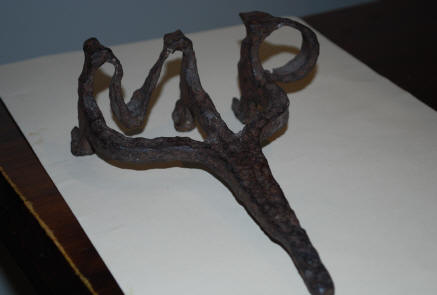
Michael Power’s branding iron.
Mary Anne Strangwidge told me the circumstances of her grandfather’s death. Michael was driving a bullock team to Eden when he was taken ill. Word reached Jane of his predicament and she rode to him and organised for him to be taken home. She then took up the whip and drove the team into Eden. Michael did not recover and died of pneumonia some days later.
After Michael’s death his son Tom took over the running of the farm and stayed with his mother until the end of her life. Jane survived Michael by 15 years but she still did not reach the age he had attained when he died. When she was 63 Jane was struck by cancer and died after a nine month illness on 18 March 1878. She was also buried at Corcorans Flat, presumably with Michael, but there is no memorial stone for her.
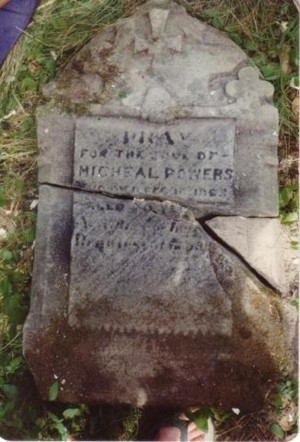
Michael’s headstone which I found broken in the small cemetery at Corcoran’s
Flat, Kiah. The inscription reads “PRAY/ for the soul of/ MICHEAL POWERS/ who
died Feb 10 1863/ Aged 70 years/ Native of (illegible)/ Requiescat in pace” Note
the two shamrocks at the top of the stone.
The Children of Michael and Jane
1. John Power (1843- 1925)
John was very young when the family moved to Boyd Town but he always claimed that he could distinctly remember Ben Boyd giving him pennies as he played at the beach.
John grew to be a powerful young man as from an early age he had to help his father in the gruelling work of clearing the farm. But he was to find fame not on the land but on water. He came to be respected as one of the best of the Twofold Bay shore whalers.
He was financed for a time by Mrs Barclay in raising a crew on the Eden side of the bay to compete against the Davidsons whose whaling station was beyond Boyd Town to the south. However, it was difficult to compete with the Davidsons who had access to Boyd’s old look-out tower on the south head of the bay and whose crew seemed to be uncannily assisted by the Twofold Bay pack of killer whales that set upon the great mammals. Mary Anne Strangwidge told me “the killers were Davidsons’ dogs”.
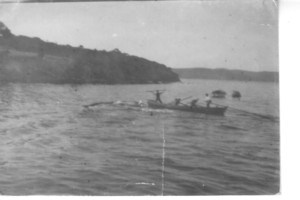
I was told that
this is a photograph of Black Johnny harpooning or lancing a whale at Twofold
Bay.
John’s rowing prowess made him one of the first crew choices in whale boat races at local regattas. From those events he graduated to compete in single sculls races with great success, at first locally and then later in Sydney against famous scullers such as Beach, Hanlon, Trickett, Laycock and Pearce. He had the distinction of being the first man ever to defeat Pearce in a race.
The last of the Eden whalers, Bill Greig, told me: “Black Johnny pulled against Mick Rush on the Parramatta River. Alex Davidson took a crew to Sydney for a whale boat race. He took his three sons, my father (Alec Greig) and Black Johnny Power. They did a practice run and then no one would race them.”
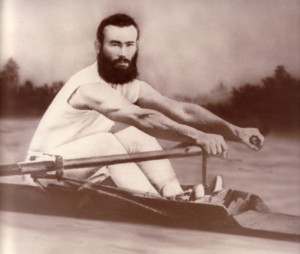
John
Power – champion sculler
When he was about 18 another young man of the same name started travelling down from Wyndham to court his sister Anne. Having two men called John Power in the house at the same time was so confusing that someone chose to distinguish them through their hair colour by naming the Wyndham visitor Red Johnny and the dark haired sculler Black Johnny.
Black Johnny was, however, the first to marry. At Eden on 29 August 1863 he wed Honorah Ryan, the seventh child of Daniel and Mary Ryan, neighbouring farmers in Kiah. By marrying Honorah, John reversed the practice in his family of old men marrying young brides: he was 19 and Honorah 28. Honorah had been born in Bansha, Co Tipperary in 1835 and at the age of four had travelled with her family to Australia. The Ryans settled on a portion of land that jutted out into the Kiah River which became known, appropriately, as Paddys Point. John and Honorah went to Eden to live and their first three children were born there. The next child was born at Little Plain near Bombala but the last four children were born at Kiah.
The eight children were:
1. Mary Jane Power (1863-1907)
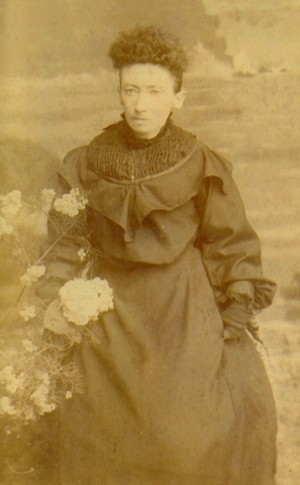
Mary Jane Power who suffered the consequences of rheumatic fever almost all of
her life.
2. Annie Power (1865-1943), m Charles Timothy Jess (1864-???) at Eden in 1865 The births of the children were registered at Eden except for Violet’s which was at Candelo.
1. Raymond J Jess (1886) m Mary J Lynch at Murwillumbah in 1919.
2. Mary (“Sissie”) Jess (1888),
3. Violet M E Jess (1889),
4. Eileen V Jess (1891-1892),
5. Cyril Desmond E Jess (1895-1978) m Emily E Best-Carter in Sydney in 1921.
6. Wilfred C Jess (1903-1912). Wilfred died in Sydney at the age of 9. His death was registered at Waterloo.
Charles Timothy Jess died in Sydney in 1938 and his wife Annie at Marrickville in 1943.
3. Norah (“Norrie”) Power (1868-1938) m James Jess (1858-1940) at Pambula in 1891. Their children were both born at Eden.
1. Monica Mary (“Monnie”) Jess (1892-1954) m Nicholas McCann at Murwillumbah in 1914 and
2. John Lambert (“Jack”) Jess (1894-1974) m Elizabeth M Sheils (1904) at Murwillumbah in 1933.
The Jess family information is available on the Monaro Pioneers’ website under ‘John George Jess’.
4. Michael Power (1869-1938) m Hariette Henriette (“Ettie”) Quinn (1875-1945) at Little Plain near Bombala in 1894. Their seven children were all born at Eden.
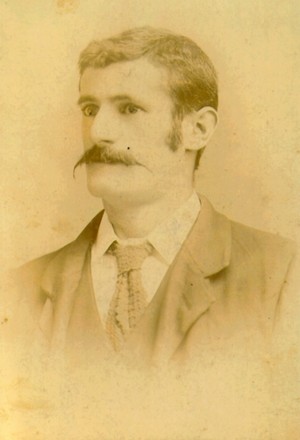
Michael (‘Black Mick’) Power. (Red Johnny Power also had a son named Michael and
he became as ‘Red Mick’ to distinguish him from his cousin.)
1. Anne Power (1894-C1987) m John A Davidson (1890-1926) at Redfern in 1914. One night in 1926 John and Ann were returning across the bay with their three children to East Boyd from a function at Eden and their boat was overturned on the bar of the Kiah River outlet. Tragically, John and two of the children, Roy aged 10 and Patricia 3, were drowned.
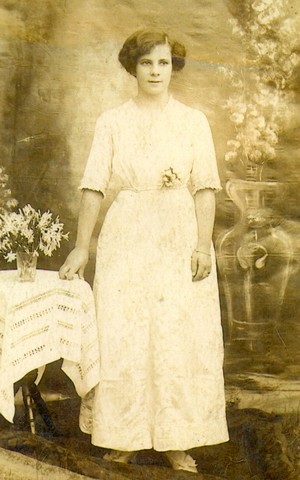
Ann Davidson (nee Power) who lost her husband and two children in a boating
accident at Twofold Bay.
2. Nora Marion Power (1897) m John McCarthy at Redfern in 1918,
3. Elias J Power (1898),
4. Michael Norman Power (1901) m Dorothy E Williams at Newtown, Sydney in 1925,
5. Irene M (“Molly”) Power (1906),
6. Ellen M (“Nelly”) Power (1909) and
7. Francis C Power (1911-1917).
See the Monaro Pioneers’ website under ‘John Laurence Quinn’ for more information about Hariette’s extended family.
5.Daniel Power (1872-1957) m Matilda (“Tilda”) Newlyn (1874-1959) at Nethercote in 1908. Their children were born at Eden.
1. Florence M Power (1909) and
2. Dulcie M Power (1913)
There are records of two girls of these names marrying in Nowra in the late 1920s.
Matilda Newlyn had previously been married to James Albert Love who died in Pambula on 14 August 1906.
See www.monaropioneers.com under ‘William Newlyn’ for more details of the Newlyn descendants.
6.Catherine(“Katie”) Power (1874-1888)
7.Johanna Power (1877-1971) m Paul Wolfe (1875-1941) at Pambula in 1910. Their four children were
a. Marion Agnes Wolfe (1911-2007) m Harold Leslie White (1895-1954) at Burringbar near Murwillumbah in 1930,
b. Ellen Doreen Wolfe (1914-2009) m Colin Spencer Smith (1910-1981) at South Brisbane in 1939,
c. Daniel Claude Wolfe (1915-1995) and
d. Paul John (“Jack”) Wolfe (1920-1958) m Joyce Patricia Buckley at Murwillumbah in 1940.
8.Ellen (“Nellie”) Power (1879) m Albert Wolfe (1876) in 1902 at Eden. Their four children were
e. Michael J Wolfe (1902) m Lucy F Benefield (1904) at Redfern in 1926,
f. Mary Norah E Wolfe (1904) m Arthur G Leo (1905),
g. John J Wolfe (1907) m Agnes A Fitzhenry at Sydney in 1926 and
h. Albert D (“Bert”) Wolfe (1909) m Mavis M Bond (1912) at Redfern in 1934.
Go to www.monaropioneers.com and look under ‘Michael George Wolfe’ to locate more information about the family of Paul and Albert Wolfe.
Black Johnny had a reputation for being hot-tempered but as he grew older he became calmer and his family spoke of him as “having a heart of gold”.
Like his parents he and Norah had their sadnesses with two of their daughters suffering rheumatic fever. Catherine died of it at the age of 13 but Mary Jane lived on as a cripple into her forties. The second youngest child, Johanna, nursed Mary Jane for all those years and refused to marry until after Mary Jane’s death in 1906 and her mother’s death in 1908.
Bill Greig told me about working with old Black Johnny Power on a couple of jobs. “Black Johnny worked as a rouseabout in the Australasian Hotel. He had a temper. We were putting up a plaster and lath wall in the hotel. He got hit in the eye with a lath and did his block – hacked up the lath with a hatchet. Then he laughed.”
After Johanna married Paul Wolfe and went with him to live at Delegate, John was left alone in the home in Eden. In 1918 Johanna was advised to move to a warmer climate but before heading off to the Tweed she talked her father into going with her. In 1920 the family moved to Sydney for about 18 months but returned to the Tweed where Black Johnny spent his final days.
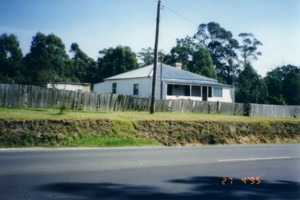
Black Johnny’s home in Eden
His granddaughter Marion White remembers him sitting in his rocking chair singing his favourite song, “Loch Lomond”. She has never forgotten him telling her what a hard life he had had to experience as a labouring man and adding, “If I had my time over again I’d far rather be dead than have no education”.
His words would have been echoed by thousands of poor people of his generation whose lack of the most rudimentary education had condemned them to a life of poorly rewarded toil.
John died in 1925 aged 84 and is buried at Murwillumbah.
%20and%20Black%20Johnny2.jpg)
‘Black Johnny’ Power is standing between Jane Jess and his daughter, Norrie, who
was the wife of Jane’s eldest son, James Jess. Behind Norrie is her daughter
Monnie (Mrs McCann). The little boy is Monnie’s son, Cyril Mc Cann.
2. Thomas Power (1844-1893)
Thomas remained a bachelor for much longer than his elder brother - he did not marry until after the death of his mother - and he was 35 before he married a girl from another large Kiah family. His bride was Mary Pendergast; they married in Eden in 1879 and settled in Kiah. Mary asked Red Johnny and Anne Power, who were now living on Michael and Jane’s former farm, if their five year old daughter, Mary Anne, could come to stay with her as, being used to a large family, she was lonely during the day while Tom was away working. Mary Anne stayed with Tom and Mary for two years until her family moved to Eden in order that the children could go to school. By then Tom and Mary had taught Mary Anne her letters and her tables so she found school no trouble at all.
By that time Tom and Mary had started their own family. Their five children were
1. Walter Thomas Power (1881) m Agnes Sawers (1881) at Eden in 1905. Their children were
1. Mena Mavis M Power (1906) married Laurence Claude Bulloch at Burwood, N.S.W. in 1937.
2. Alma M A Power (1909) married George J Carter at Parramatta in 1934.
2. Jane Frances Power (1882-1942) m William Donaldson Roberts (1868-1953) at Sydney in 1911. Their eight children were
1. Francis Vincent Roberts (1912-1993) m Lyla Florence Peters (1914) in 1940.
2. Joyce Cecily Roberts (1914-1983) m Ronald Walker in 1934 at Bankstown.
3. Verlie May Roberts (1917-1979) m Phillip Suffolk Sleap at Bankstown in 1942.
4. Olive Mary Roberts 1919).
5. Esme Clare Roberts (1921-1979) m William James Lynch in 1941 at Bankstown.
6. John William Roberts (1924-1981) m Edna (“Peg”) Brownlow in 1948,
7. Vonnie Theresa Roberts (1924) m Kelvin Ronald Bruce Hockley at Bankstown in 1944
8. Max Roberts (1927) m Faye Marie Walaron in 1955.
3. Patrick Albert Power (1885-1909) m Madeline Maude Ryan at Paddington in 1917. Their three children are
1. Alwyn Power (1917 ). He married Gladys Edith Robinson at Canterbury in 1945.
2. June Power m Archie Demer at Paddington in 1940.
3. Lawrence (“Tim”) Power
4. Johanna Teresa Power (1887) m Henry L Karsten in Sydney in 1911. Their only child is Vera M Karsten (1911) m Henry J (“Harry”) Mats in 1930 at Bankstown.
5. John Dillon Power (1889-1919) m Maude ? Their son was John Power (1919)
Tom became very ill with yellow jaundice when the children were quite young and Mary Ann Strangwidge remembers his brother Black Johnny working his own shifts at the mine and then working second shifts to keep money coming into Tom’s household. Sadly Tom died in 1893.
3. Anne Power (1846-1918)
Anne married Red Johnny Power at Eden in 1864. Their history has already been recorded in “The Story of John Power and Anne Power and their Family” that can be found on the Monaro Pioneers’ website. One point that may not have been clearly made in that story was that John and Anne either bought her father’s farm back from Patrick Pendergast or took it over after Patrick’s lease had expired and raised their children there from about 1875 until 1883. In 1883 they leased the farm and moved their family to Eden.
Anne Power
4. Catherine Power (1848-1925)
Catherine (or Kate as she was more generally known) was wooed and won by James Power, a younger brother of Red Johnny. They were married at Kiah in the home of Patrick Pendergast in 1872. This was actually the house that Kate and her brothers and sisters had grown up in so the wedding there would have been a particularly happy occasion for the family.
Jim and Kate lived in Eden and their nine children were born there. Jim worked as a labourer and a miner but for a time was the publican of the Pier Hotel. On 29 May 1886 there was a terrible shipwreck at Green Cape and 72 lives were lost. The body of an elderly woman was recovered from the sea and brought to the Pier Hotel where Kate, her sister Anne and Mrs Strangwidge senior, the district midwife, laid out the deceased.
The dead woman was later identified as Flora McKillop the mother of Mother Mary McKillop.
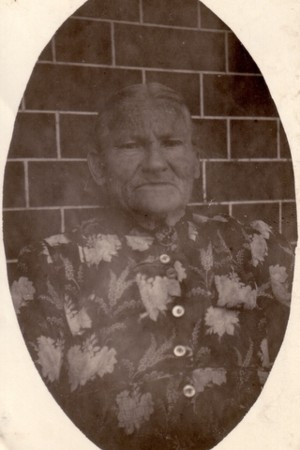
Kate Power in her old age at Brunswick, Victoria.
See “The Story of James and Kate Power” in the Monaro Pioneers’ website for a more comprehensive account of their lives and the lives of their descendants.
5. Jane Power (1850-1914)
Jane married Charles Stokes at St Mary’s, Bombala on 29 May 1873. Charles was a teamster at Bombala Station and Jane was a servant working at Bombala.
Charles had been born in 1849 at Dellicknora in Victoria, not far across the border from Delegate.
The births of all of their children were registered at Bombala indicating that they were living in that district until at least 1896. Their nine children were:
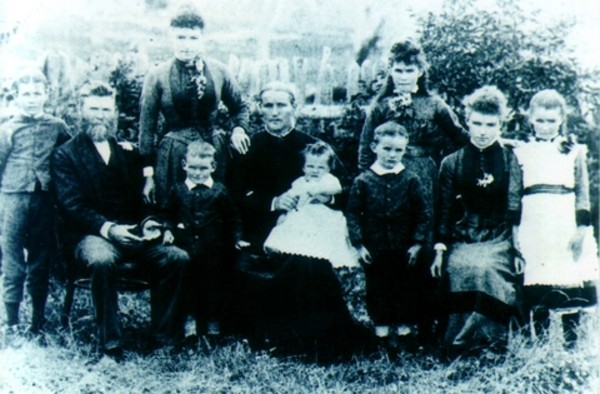
The
Stokes family: From left – John, Charles, Sarah, William, Jane nursing Norah,
Charles, Ann, Agnes and Mary. This photo was taken in about 1892. The ninth
child, Alice, was born in 1896.
1. Sarah Catherine Stokes (1874-1953) married William Clear (1868-1942) at Bombala in 1897. Their children’s births were all registered at Bombala.
1. Sarah Jane Clear (born 1897-1987) m. Arthur Ingram. Their children are
1. Allen Ingram
2. Max Ingram
2. Imelda Bridget Clear (1900-1960),
3. Charles William John Clear (1901-1987) m Olive E Elliott at Bungendore in 1928.
4. Thomas Edmond Clear (1903-1961),
5. Leo Patrick Clear (1905-1963) m. Catherine Doris Buckley at Cooma in 1937.
6. James Joseph Clear (1907-1946) m. Mavis A Tolhurst at Warren in 1934.
7. Mary Agnes Clear (1909-1965),
8. Norah Louise Clear (1912-19??) m. Michael J Manning at Cooma in 1930.
9. Robert Harold Clear (1920-1968)
There is a record of a William Clear dying at Cooma in 1942. He was the son of William and Sarah Clear. There is also a record of a Mary Clear (a daughter of William and Sarah Clear) dying in North Sydney in 1926.
2. Agnes Jane Stokes (1876-1927) m Arthur Ingram (1875-1960) at Delegate in 1900. Their children were born at Bombala.
1. Arthur Charles John (“Jack”) Ingram (1901-19??) m. Florence K Baragry at Cooma in 1926.
2. Mary Jane Nora (“Maisie”) Ingram (1903-1994) m. William H Crawford at Bombala in 1922.
3. Margaret Ann (“Annie”) Stokes (1878-1950) m Thomas Nicholas Oliver (1881-1944) in 1901 at Delegate. Their children were
1. Stella Jane Oliver (1901-1953) m. George R Sinclair in Paddington in 1928.
2. Maud Alice Elizabeth Oliver (1903-1961),
3. Leslie Thomas Oliver (1907-1980),
5. Nora Ellen (“Nell”) Oliver (1910-1963),
6. Marie Grace Oliver (1912-1982) m. Leslie W Oxborrow at Bombala in 1930.
7. Clifford Earl Michael Oliver (1914-1981) m. Sylvia Delitha Robertson at Granville in 1940.
8. Douglas Clyde Oliver (1921-1945) m. Emily Veronica McLenaghan in 1942 in Granville.
9. Stirling Carmelitia (“Stirlie”) Oliver (1924-1980) m Bruce Arthur Lewis in Waverley in 1943.
Thomas died in 1944 and the following year Margaret married Edward Daniel Ryan in Cooma.
4. John T Stokes (1881-1948) m Ellen Vida (“Nell”) Morrison (1887-1966) at Bombala in 1907. Their children’s births were all registered at Bombala.
1. Alice Jane (“Jean”) Stokes (1909) m. Cyril B Ingram at Bombala in 1933.
2. Mary Nora (“Molly”) Stokes (1911)
3. Inez Anne Stokes (1913) m. John Thomas Lock at Bombala in 1936.
4. Stanley John Stokes (1916) m. Gloria Maylettha Targett at Bombala in 1943.
5. Edna Catherine Stokes (1918) m. Kitchener Clive Cottrell at Paddington and at Delegate in 1939.
6. Dorothy Phyllis Stokes (1920) m. Brian James McQuillen at Delegate in 1943.
7. Hazel Ellen Stokes (1922) m. Allen Vincent Best at Delegate in 1941.
8. Joy Ena Jean Stokes (1925)
5. Mary E Stokes (1884-1916) m Albert William Rozynski Their children were
1. Verona A Rozynski (1909)
2. Bell Rozynski,
3. Olga S Rozynski (1914),
4. William Rozynski (1914)
5. Bertha Rozynski,
6. Reta Rozynski
6. Charles Michael Daniel Stokes (1886-1960) m Ethel O Elton (1889-1928) at Bombala in 1911. Their two babies died as infants.
1. Horace C Stokes (1912-1912)
2. Eunice K Stokes (1917-1917)
Charles remarried five years after Ethel’s death to Olive P Ingram (1894-19??) Their one son was Moyston Stokes.
7. William Frederick Stokes (1888-1969) m Gladys Jackson at Bega in 1917. Their two children were
1. Gordon Cyril Stokes (1920-1946) and
2. Joyce Stokes (1924)
8. Norah Rebecca Stokes (1892-?) m Michael Peacock at Bombala in 1921.Their four children are:
1. Mary Peacock (1922),
2. Michael Peacock,
3. Geradine Peacock and
4. Mortimer Peacock
9. Alice Esther Stokes (1895-1962?) m Evelin Halstead Jenkins (1898-1976) in St Mary’s Cathedral, Sydney in 1921. Their four children are:
1. Evelyn Jenkins,
2. Stan Jenkins,
3. Thelma Jenkins and
4. Josephine Jenkins.
As a young woman Jane was a good swimmer and Mary Ann Strangwidge remembers Jane teaching her eldest brother John how to swim in the big water hole near their farm at Kiah.
My father, Joe Power, had fond memories of spending holidays with his Great-aunt Jane when he was a young child living at Dellicknora in the Victorian high country not all that far from Bendoc. He remembered being scared by the geese.
Charles died at Quinburra, Lower Bendoc, Victoria in 1909 aged 60 and Jane passed away in the Jenner Private Hospital in Sydney in 1914. However, she had been living at Lower Bendoc up until the time of her final illness. They are buried together at Delegate.
Headstone of
Charles and Jane Stokes at Delegate Cemetery
The following obituary appears on the Monaro Pioneers’ website under ‘William Simon Stokes’. Note that it states that she was the daughter of John Power which was incorrect. Her father was Michael Power.
OBITUARY - Mrs Jane Stokes
- 'Delegate
Argus' - 9 April 1914 edition
Deep and general regret was expressed on all sides when word reached town on
Thursday last Mrs Jane Stoke, of Quinburra, had passed away in Sydney that
morning. The deceased lady had not been enjoying good health for some time, and
some weeks ago proceeded to Sydney, where she entered the Jenner Private
Hospital and underwent a serious operation. This was successful, and it was
fondly hoped by her immediate connections that it would not be long ere she was
sufficiently recovered to return home. However, God willed otherwise, for on
Wednesday she took a bad turn from which she never rallied, and, sinking
rapidly, passed peacefully away as mentioned above. Two of her daughters and
one of the sons were with her at the last.
The deceased was the widow of the late Mr Charles Stokes, and was a native of
Eden, being a daughter of the late Mr and Mrs John Power. After her marriage
she resided for many years at Rocky Range, near Delegate, but later removed to
Quinburra. She was widely known through the district and the widespread regret
that is expressed at her demise shows the high esteem in which she was held. A
splendid neighbour, she was likewise renowned for her charitable disposition,
and no worthy appeal was ever made to her in vain. In her home-life she was a
good wife and an ideal mother, and no sacrifice was too great for her to make
for her family. Mrs Stokes was in her 63rd year, and leaves a family of three
sons and six daughter, they being Messrs. J. T; William and Chas. Stokes,
Mesdames W Clear, Arthur Ingram, Thos. Oliver, A. Rozynski, and Misses Nora and
Alice Stokes. To these and the other relatives we extend our deep sympathy.
The remains were brought to Cooma by train on Saturday morning and thence on to
Delegate, where they were interred in the Roman Catholic portion of the cemetery
on Sunday. The funeral was one of the largest ever seen in Delegate, people
coming from all portions of the district to show their last mark of respect to
one who was generally beloved.
In the absence of Rev. Father McCormick, Mr C P Gibb conducted the prayers at
the graveside.
The funeral arrangements were in the hands of Mr Robert Moore of Bombala.
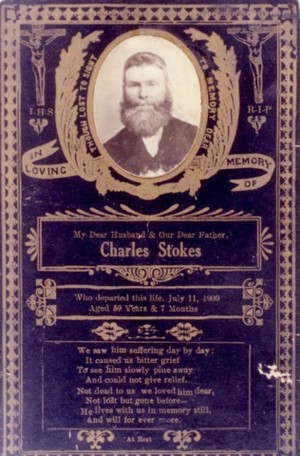 |
 |
Memorial cards of Charles Stokes and Jane Stokes
6. Michael Power (1852-1855)
There is not much more that can be said about this little boy who drowned in the river that ran past his parents’ farm. Sadly, he died too young to have a story.

 Monaro
Pioneers
Monaro
Pioneers